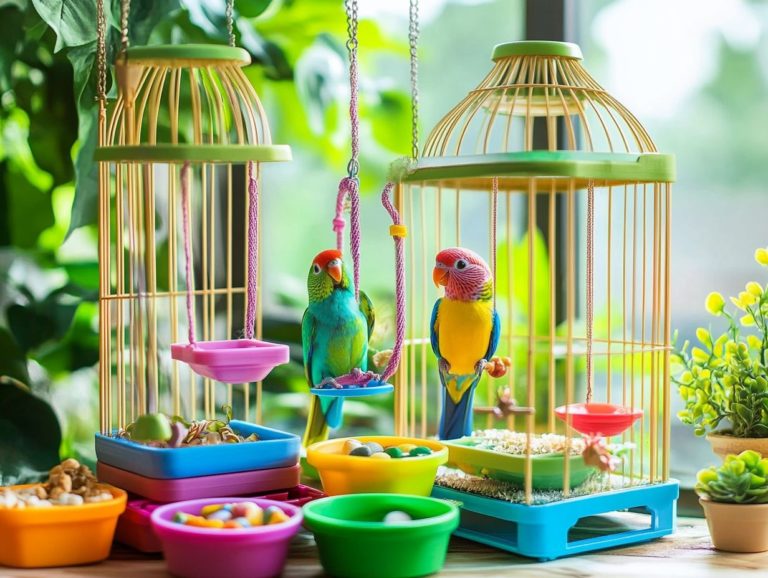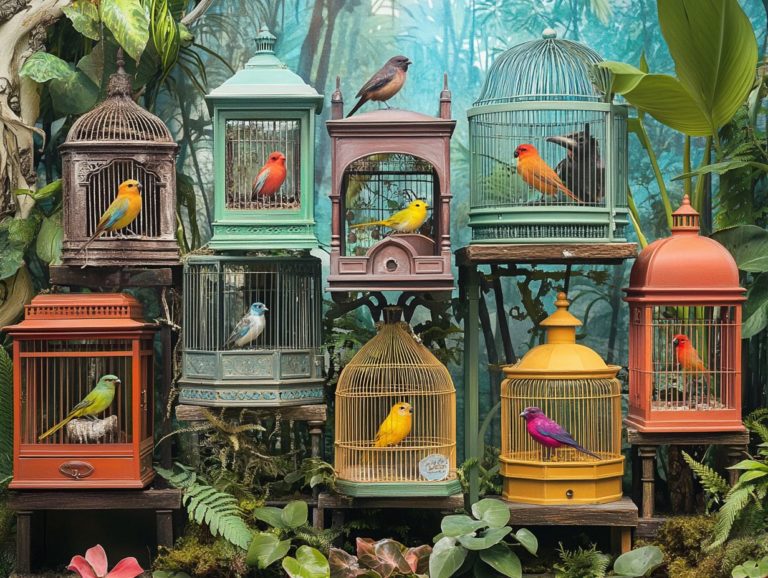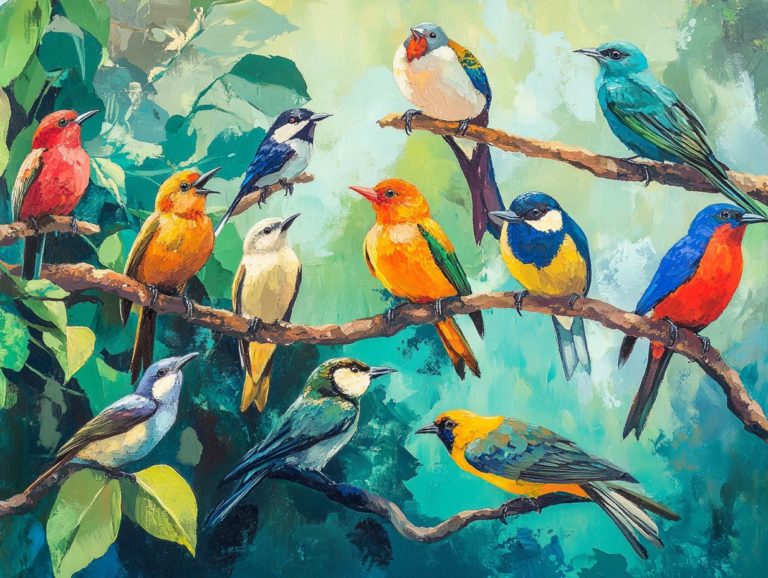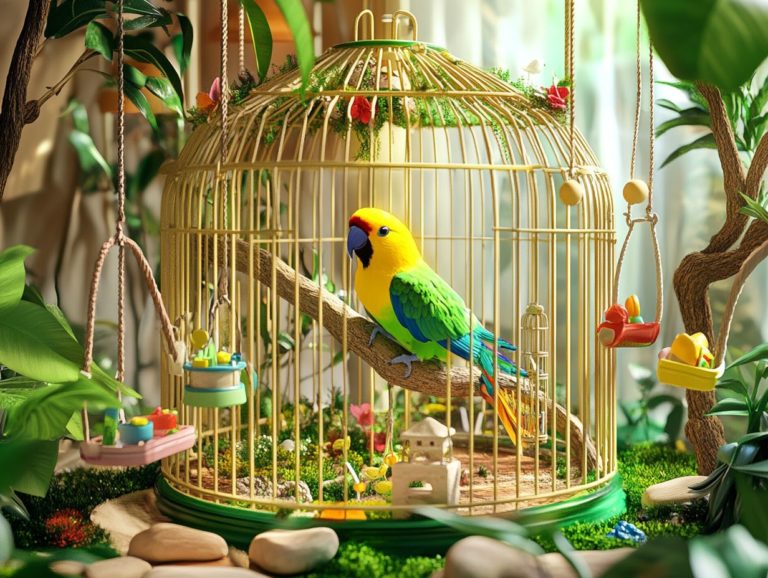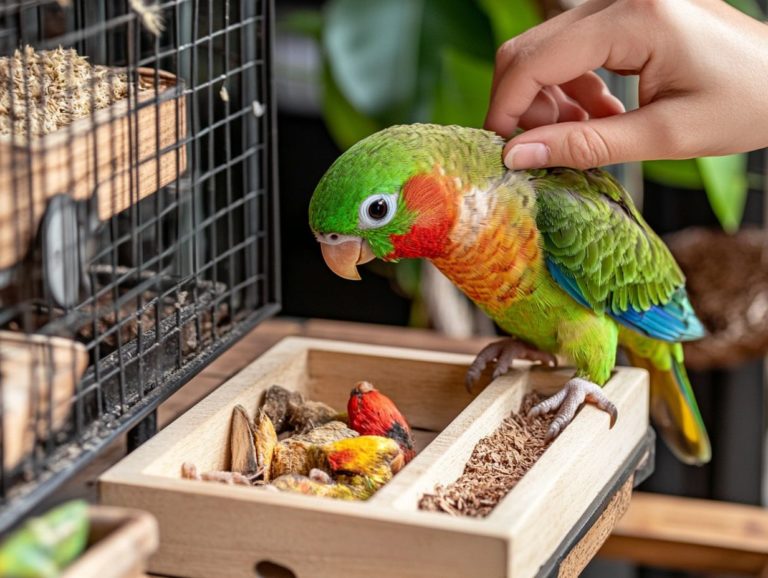Creating a Bird Sanctuary in Your Backyard
Creating a bird sanctuary in your backyard is not just a rewarding endeavor; it transforms your outdoor space into a vibrant haven that supports local wildlife.
This guide will delve into the myriad benefits of crafting a sanctuary for birds, from the sheer joy of observing their unique behaviors to the positive effects on your local ecosystem.
You ll learn how to choose the ideal location, attract feathered friends with native plants, provide them with shelter, and maintain your sanctuary effectively to promote conservation efforts.
Discover how to turn your backyard into a thriving refuge for birds and immerse yourself in the beauty of nature up close!
Contents
- Key Takeaways:
- Benefits of a Bird Sanctuary
- Choosing the Right Location
- Attracting Birds to Your Backyard
- Creating Shelter for Birds
- Maintaining Your Bird Sanctuary
- Dealing with Common Issues
- Enjoying Your Bird Sanctuary
- Questions People Ask About Bird Sanctuaries
- What is a bird sanctuary?
- Why should I create a bird sanctuary in my backyard?
- What are the key elements of a bird sanctuary?
- Do I need a large backyard to create a bird sanctuary?
- How can I attract different types of birds to my backyard sanctuary?
- Are there any regulations or permits required for creating a bird sanctuary?
Key Takeaways:
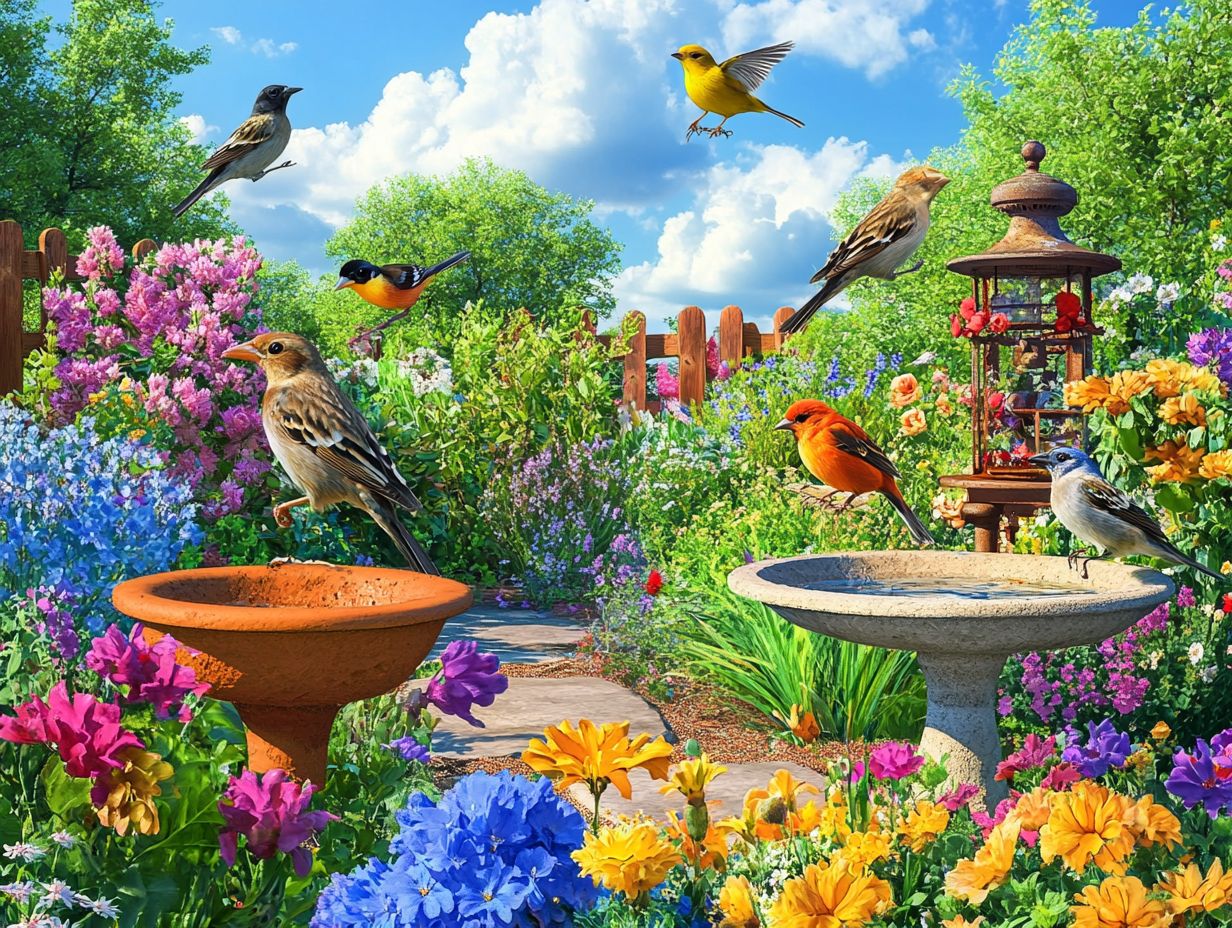
- Creating a bird sanctuary in your backyard provides numerous benefits, including promoting biodiversity, reducing pests, and providing a peaceful and enjoyable environment.
- When choosing a location for your bird sanctuary, consider factors such as food and water sources, shelter, and safety from predators.
- Attract a variety of bird species by planting native plants, providing food and water sources, and building birdhouses and nesting materials in your backyard.
Benefits of a Bird Sanctuary
Establishing a bird sanctuary offers many benefits. It helps local wildlife while enriching your outdoor space, especially when you learn how to create a bird-friendly backyard.
By creating a safe haven for diverse birds, you boost local biodiversity and support conservation efforts. This also opens doors for educational opportunities, highlighting the importance of nature.
A bird sanctuary acts as a crucial platform for community engagement, raising awareness about the environmental consequences of our choices. It nurtures a profound appreciation for nature and its intricate balance.
Why Create a Bird Sanctuary?
Creating a bird sanctuary is important for helping local birds and meeting the goals of groups like the Audubon Society, especially by learning how to create a bird play area outside.
Such sanctuaries serve as safe havens for vulnerable bird populations, ensuring they have the essential resources needed to thrive. By establishing protected areas, you can actively promote biodiversity, which refers to the variety of different species in an area.
Engaging local residents in conservation efforts fosters a sense of stewardship. This encourages educational programs that raise awareness about the significance of wildlife habitats. By prioritizing these initiatives, you contribute to a broader effort to combat habitat loss and preserve the beauty of nature for generations to come.
Choosing the Right Location
Choose the right spot for your bird sanctuary. This is crucial for meeting the needs of the birds you want to attract, and you can learn how to create a cozy bird nesting area to make it even more inviting.
Look for places near food and water sources. Evaluate the shelter available to ensure a safe environment.
Understanding the surrounding ecosystem helps you create a safe haven that fosters biodiversity.
Factors to Consider
When selecting a location for a bird sanctuary, you must consider several key factors, such as habitat availability, feeding opportunities, and a dependable water source.
To foster a thriving environment, evaluate the natural characteristics of the area, including the types of vegetation that attract a diverse array of bird species. Understanding the local food chains will guide you in pinpointing the best feeding opportunities, whether that s insects, seeds, or fruits.
Accessibility to water is critical; birds need safe spots for drinking and bathing. This can greatly influence their nesting and breeding success. By thoughtfully assessing these elements, you can create a sanctuary that sustains current bird populations and encourages the return of migratory species.
Attracting Birds to Your Backyard
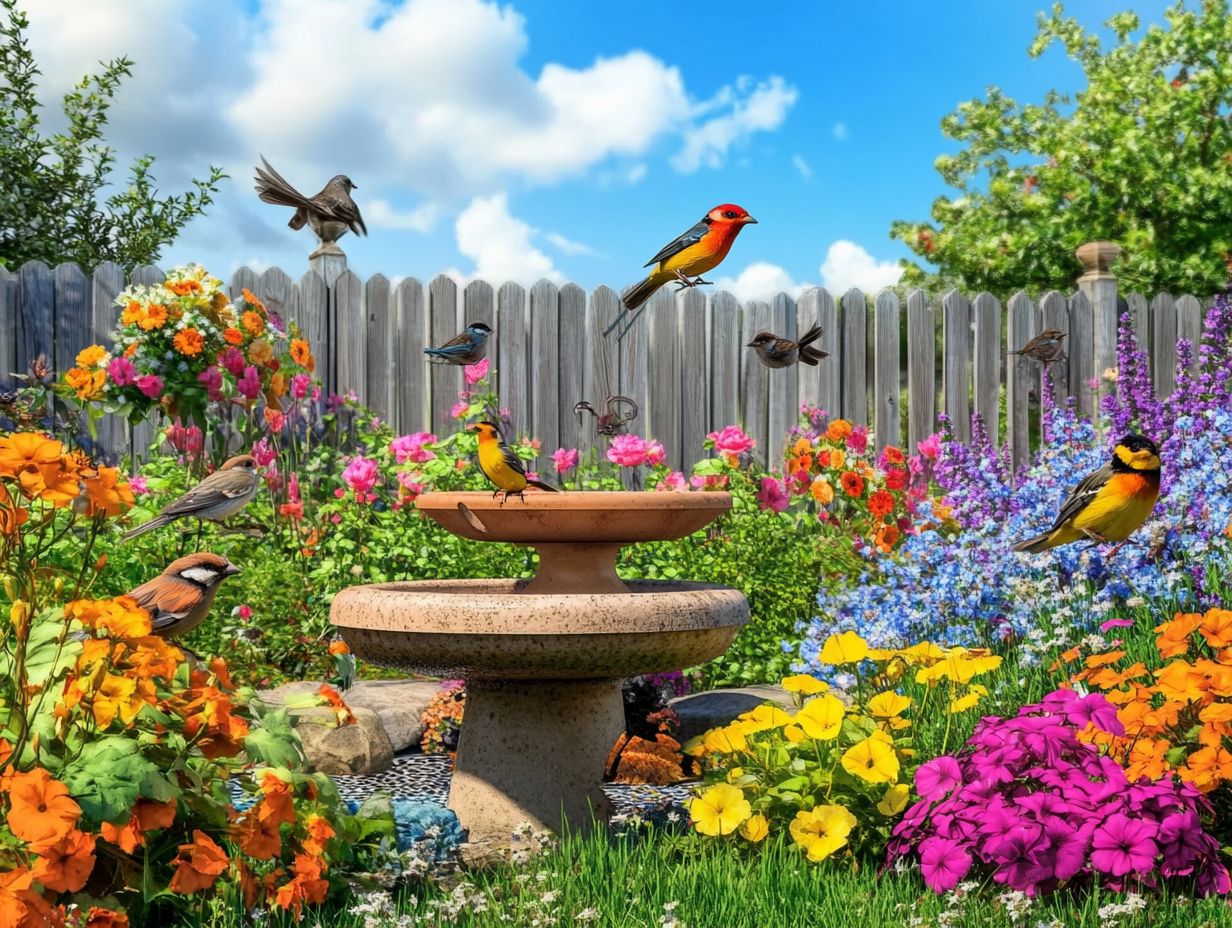
Attracting birds to your backyard is within your reach when you embrace strategic gardening practices. Consider planting native plants that provide nourishment and shelter for these feathered visitors.
Install bird feeders and baths to provide reliable water sources, creating an inviting oasis for various birds to enjoy.
Planting Native Plants and Providing Food and Water Sources
Native plants are crucial for attracting birds. They provide natural food sources and habitats.
When you strategically place bird feeders and water sources, you significantly enhance the biodiversity of your backyard. The relationship between native vegetation and avian visitors is profound; birds depend on these plants for seeds, fruits, and shelter. By incorporating native flora into your garden design, you create a more inviting environment that supports local ecosystems while adding visual beauty.
When selecting plants, focus on species indigenous to your area, as these will thrive best in your specific conditions. Consider adding small water features like bird baths or ponds to provide essential hydration, transforming your garden into a true haven for feathered friends.
Regular maintenance, like removing debris and keeping water sources clean, ensures that these spaces remain welcoming and beneficial for birds, ultimately enriching the biodiversity of your outdoor sanctuary.
Creating Shelter for Birds
Creating shelter for birds in your sanctuary is essential for their survival and nesting success. You can achieve this by constructing well-made birdhouses, providing ample nesting materials, and maintaining outdoor spaces that offer protective cover.
Building Birdhouses and Providing Nesting Materials
Building birdhouses and providing nesting materials are crucial steps in enhancing bird conservation efforts within your sanctuary. Additionally, creating a safe outdoor space for your bird establishes safe havens for various species while promoting their well-being and reproduction.
When designing birdhouses, consider factors like size, entrance hole dimensions, and ventilation, as these elements impact the comfort and safety of nesting birds. Using durable materials like untreated wood or recycled plastic will ensure longevity and resilience against harsh weather. By incorporating a range of nesting materials such as twigs, leaves, and feathers, you can attract a diverse variety of species, enriching the local ecosystem.
Providing these resources fosters a thriving avian community, which is essential for maintaining ecological balance.
Maintaining Your Bird Sanctuary
Regular maintenance of your bird sanctuary is crucial right now for fostering a vibrant and healthy environment for both birds and other wildlife. You’ll enjoy a variety of tasks to keep your sanctuary lively and healthy, including cleaning feeders, managing pests, and preventing the encroachment of invasive species.
By dedicating time and effort to these responsibilities, you ensure that your sanctuary remains a thriving haven for its feathered inhabitants and the diverse ecosystem that surrounds them.
Regular Cleaning and Pest Control
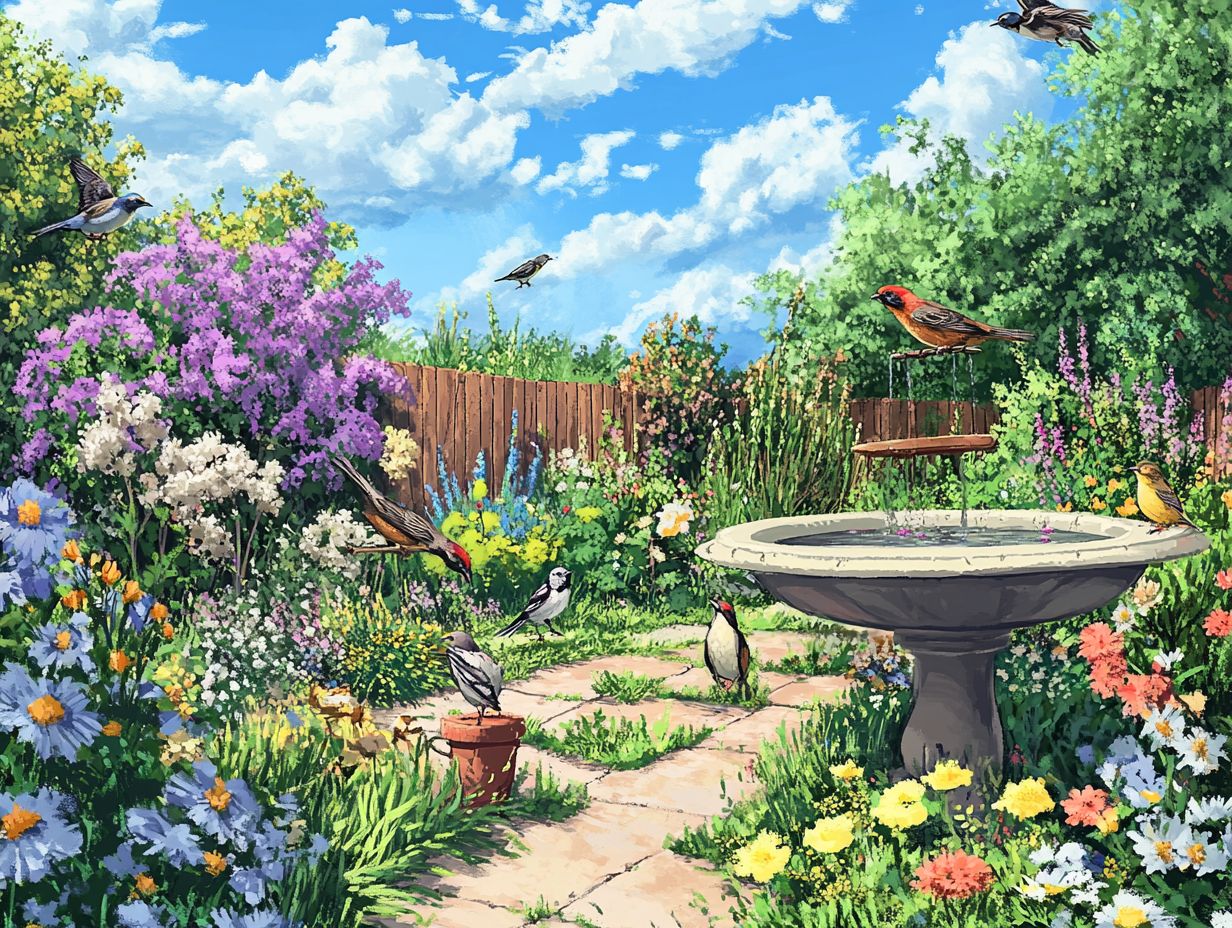
Regular cleaning of your feeders and effective pest control is crucial for maintaining bird activity and ensuring the overall success of your conservation efforts in the sanctuary. By following best practices, you can create a welcoming environment that supports avian health and well-being.
This involves routine cleaning with mild soap and water and strategically placing feeders to deter pests like rodents and ants. Utilize natural deterrents or safe traps to manage these unwelcome visitors effectively.
Installing baffles, devices that prevent larger animals from reaching the feeders, will help safeguard your feeders. Additionally, keeping the feeding area free from debris and old food is crucial to preventing the growth of mold and bacteria, which can lead to illness among birds.
Through these thoughtful actions, you foster a safe haven where birds can thrive and contribute positively to the ecosystem.
Dealing with Common Issues
Addressing common issues in a bird sanctuary such as managing predators and handling aggressive birds is crucial for ensuring a safe haven for your feathered companions.
By tackling these challenges, you create an environment where your avian friends can thrive, free from threats and disturbances.
Dealing with Aggressive Birds and Predators
Managing aggressive birds and predators, including outdoor cats and deer, is vital for the well-being of your bird sanctuary and its residents.
To create a safe haven, you must implement effective strategies to protect these vulnerable species and educate the community about the impact of such threats.
Utilizing deterrents like visual or auditory scare devices can significantly reduce conflicts with aggressive birds.
Partnering with wildlife organizations can provide you with invaluable resources and techniques for taking care of their living space.
These organizations host workshops and training sessions tailored for birdwatchers and sanctuary staff. They equip you with the knowledge to coexist responsibly and sustainably with local wildlife.
By prioritizing safety measures, you enhance the overall health of the sanctuary’s ecosystem, creating a thriving environment for all its inhabitants.
Enjoying Your Bird Sanctuary
Enjoying your bird sanctuary is about more than just meeting the needs of the birds; it presents a remarkable opportunity for birdwatching, education, and community engagement.
Observing and Learning from Your Feathered Visitors
Observing and learning from your feathered visitors can profoundly enhance your appreciation for birdwatching and the vital conservation efforts championed by organizations like the Audubon Society.
As you immerse yourself in the art of watching these vibrant creatures, you deepen your understanding of avian behavior and develop a sense of responsibility toward preserving their habitats.
Engaging in activities such as tracking various species, noting their feeding habits, and recognizing migratory patterns can foster a stronger connection to the environment.
This mindful observation may inspire you to advocate for conservation initiatives, underscoring the crucial role you can play in sustaining local bird populations.
Connecting with like-minded individuals through birdwatching clubs further enriches your experience, as shared knowledge and enthusiasm cultivate a community devoted to protecting these magnificent animals.
Questions People Ask About Bird Sanctuaries

What is a bird sanctuary?
A bird sanctuary is a designated area where birds can safely live and thrive without interference from humans or other predators.
Why should I create a bird sanctuary in my backyard?
Start creating a bird-friendly living space today to help local birds thrive! It not only benefits the local bird population but also adds beauty and diversity to your outdoor space.
What are the key elements of a bird sanctuary?
The key elements of a bird sanctuary include:
- Food
- Water
- Shelter
- Protection from predators
- Native plants
Do I need a large backyard to create a bird sanctuary?
No, you can create a bird sanctuary in any size backyard as long as you have enough space for basic necessities such as a bird feeder, birdbath, and some plants. To enhance your efforts, consider creating a bird-friendly home environment.
How can I attract different types of birds to my backyard sanctuary?
To attract a variety of birds, incorporate different types of bird feeders, offer a variety of food, and plant a diverse array of native plants that provide both food and shelter.
Are there any regulations or permits required for creating a bird sanctuary?
It’s always a good idea to check with your local government to see if there are any regulations or permits required for creating a bird sanctuary in your backyard. Additionally, consider creating a bird-friendly environment after adoption, as this may vary depending on your location and the type of birds you wish to attract.

